|
Morden Hall to Colliers Wood Walk (part 1)
A short walk along the River Wandle in south London
(Photos/words © urban75, 12th January, 2008)
After several miserable days of near non-stop rain, Saturday looked bright and sunny in London, so we headed off down the Northern Line to explore the ancient town of Morden, which dates back to Roman times.
The walk was an easy-peasy 2.5 mile affair - probably a but more for us seeing as we spent time ambling around Morden Hall Park - and you can view the route in Googlemaps  here. here.
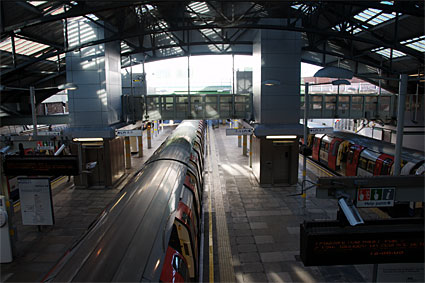
The most southerly station on the Underground, Morden station is the southern terminus for the Northern Line, and sits in Travelcard Zone 4.
When the line opened in September 1926, Morden was an open rural area providing its designer, Charles Holden, with access to enough cheap land to incorporate a parade of shops each side of the imposing station entrance.
Built in a wide cutting, the station has three platforms, of which two are island platforms with tracks on each side.
The tunnels out of Morden station are some of the longest in the world, measuring 17.25 miles (28 km) as the line makes its subterranean passage north via the Bank branch between Morden and East Finchley.

Old terraces facing Morden Hall Road.

We turned off Morden Hall Road after passing the old Morden Hall (now a pub/restaurant) and passed the stable block as headed for the well-stocked cafe.
The stable block was built by the last Hall owner, Gilliat Hatfeild, for his hunting horses.

Set on the banks of the River Wandle in Morden, the 125 acre Morden Hall Park is owned by the National Trust and dates back to the 1770s.
The park contains gardens, meadow and marshland with several historic buildings and preserved watermills from its time as a snuff grinding works.
The Hall was originally owned and occupied by the Garth family before being sold to tobacco merchant Gilliat Hatfeild (1827�1906) in the 1870s.
His son, Gilliat Edward Hatfeild (born 1864), left most of the estate (including the house) to the National Trust when he, err, snuffed it (sorry!) in 1841.

Clockhouse gate. The weather vane has a metal trout stuck at the top, reflecting Hatfeild's interest in all things a-huntin' and a-fishin'.


Mill Cottage.

Fund raising book sale.

The snuff was ground by hand until water-powered mills took over in the 18th century.
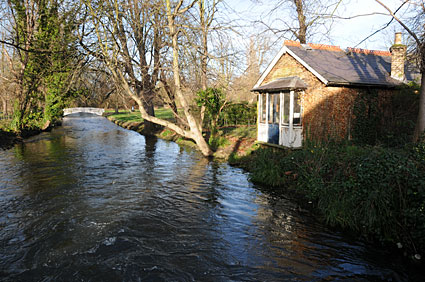
After the recent rains, there was a fair current pushing the River Wandle along.

Detail of one of the old mill water wheels.


Morden Cottage was once home to Gilliat Hatfeild, who felt that the cottage suited his bachelor lifestyle better than the Hall.
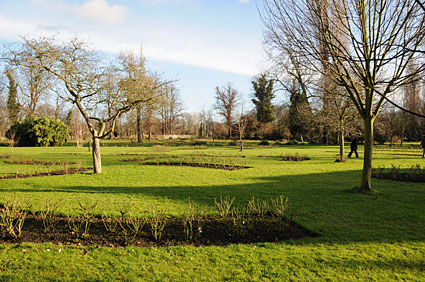
Created in 1921 and now maintained by the National Trust, the two acre rose garden contains 48 beds and apparently looks fantastic between May-Sept where you breeze in the heady whiff of 2,000 roses.
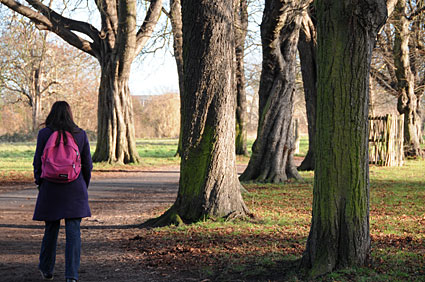
Walking through the park.

Meadow scene in winter.

Running alongside the park is the Tramlink, with the station at Phipps Bridge offering trains into Wimbledon and West Croydon line every eight minutes or so.


National Trust sign post in Morden Hall Park. We took a leisurely stroll around its circumference.

One man and his dog.

Bridge across the River Wandle.

Winter shades.

Elegant decorative footbridge in front of Morden Hall
The 1770 hall has served as a family home, boarding school for young gentlemen and a military hospital during the First World War.

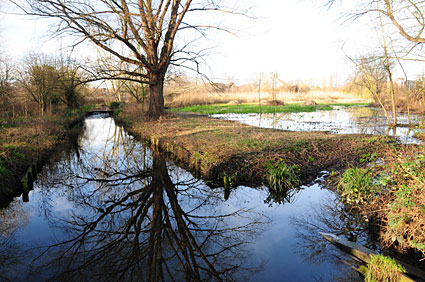
Walking across the marshlands.

The water level in the marshland to the north of the park is controlled electronically by the Environment Agency.
The area provides wetland habitats for marsh flowers, like yellow iris and marsh marigold with herons and kingfishers regularly seen by the river.

Crossing the tram line to follow the route of the Wandle.

Urban and rural.

I was curious to see if my shiny new Nikon D300 would be able to autofocus on this distant bloke's head through all the ferns. Not only did it focus on him perfectly, but exposed the tricky backlit scene with precision - you can even see the sun lighting up the man's ear!

« London features Deen City Farm, Colliers Wood »
|

